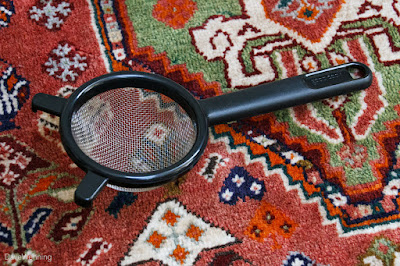Needling
We all know the basic difference between deciduous and coniferous trees. Deciduous trees drop their leaves in the fall and grow new ones in the spring. Conifers are evergreens that hold their leaves (or needles) year around. But that's really not the whole story. In fact, conifers drop needles continuously all year around. The big Douglas Firs in my yard and the wind like to send needles into the rain collector of my weather station. These can clog the aperture in the bottom of the collector. To deal with this, I devised a successful strategy using a kitchen strainer to catch the needles.
About a year ago, Davis Instruments revised the design of their collector for the Vantage Pro2 station. It included a debris screen that fit in the bottom of the bucket. This looked like a good idea so I ordered one.
Unfortunately, as you can see in the photo, the slots in the new debris screen are too large to hold back the fir needles. Three or four times this winter I have noticed the station not recording rainfall while it is pouring rain outside. Upon inspection, I found four to six inches of water trapped in the bucket. The needles had clogged the aperture. This prevented the rain from passing through and tipping the switches that measure the 0.01 in/2 mm rainfall increments. Interestingly, when the aperture is unclogged, the station reports a rainfall rate of 31 inches/79 cm per hour, quite a deluge.
Time to reconsider my kitchen strainer strategy. This is the smallest plastic one I could find, about 3 inches/7.6 cm in diameter. The handle and supports snap off easily with a wire cutter. I filed down the broken edges to create a smooth round frame around the strainer. I was careful not to change the round, dome shape of the wire.
I placed the strainer screen down in the rain collector. The screen is too small to allow the fir needles to pass into the aperture, but the rain drops will flow right through it. It is now only necessary to check it once in a while and suck out trapped needles with a portable vacuum.
I am aware that Davis doesn't approve of jury-rigging their station sensors like this. Also, there will be purists who might question the accuracy of the data collected. Nevertheless, my annual rainfall results have always been consistent with the National Weather Service results for this location. Of course, preventing a clogged sensor would seem superior to no data at all.




